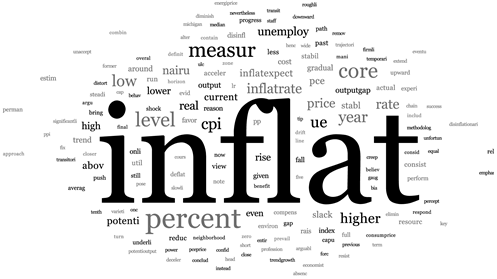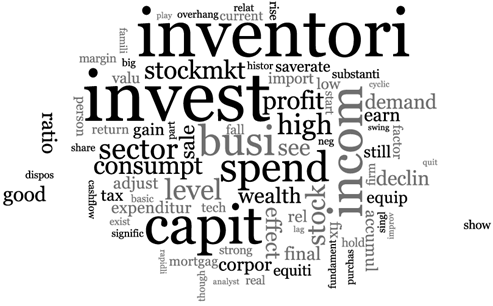Introduction
The world’s major central banks display significant differences in transparency. The European Central Bank currently publishes no direct information on its internal policy debates, and will only release minutes with a 30-year lag. The Bank of England releases minutes soon after meetings, but withholds transcripts. The Federal Reserve (Fed) releases both minutes and transcripts of the Federal Open Market Committee (FOMC) meetings after a five-year lag. At the same time, these policies are under review, with ECB President Draghi having spoken of the desirability of “a richer communication about the rationale behind the decisions that the governing council takes” (Financial Times 2013), and the Bank of England actively considering the release of future transcripts (Bank of England 2014).
So what is the right level of transparency? Clearly some transparency is required for democratic accountability, but what are the costs and benefits of increasing the public’s information about the policymaking process?
The primary channel through which theory suggests transparency matters for policymakers’ behaviour is career concerns, the idea that experts wish to protect their reputation for competence. The main positive effect of transparency due to career concerns, present in Holmström’s (1999) classic paper, is that increased visibility provides additional incentives for committee members to work hard to identify appropriate policies. The main negative effect, predicted by Prat (2005), is that policymakers become conformist and begin parroting the views of their colleagues to avoid standing out, leading to a stifled and uninformative debate. When speculating on the effect of releasing transcripts in 1993, FOMC Chairman Alan Greenspan expressed exactly this concern: “I fear in such a situation the public record would be a sterile set of bland pronouncements scarcely capturing the necessary debates which are required of monetary policymaking” (Greenspan 1993).
Our paper tests for the presence of these two effects, and examines which one dominates using FOMC transcript data (Hansen et al. 2014). The first challenge, familiar to applied economists, is to disentangle causal relationships. The second, much less typical, is to quantify text data and use it to study patterns of communication. We now provide details on how we address both of these before discussing the findings and their implications for central bank design.
Identifying the effect of transparency on deliberation
Since the mid-1970s FOMC meetings have been tape recorded to assist preparation of the minutes, but until late 1993 committee members believed that their content was destroyed afterwards. Then, in response to political pressure from the Senate Banking Committee, Fed staff informed the FOMC that verbatim transcripts prepared from the tapes indeed existed. Having previously denied their existence, Chairman Greenspan and the FOMC felt compelled to agree to release all back transcripts, in addition to all future transcripts, with a five-year lag. This creates a natural experiment: prior to late 1993, FOMC members deliberated under the assumption their debate was private, whereas afterwards they knew every spoken word would eventually be publicly observable. Importantly, this change arose not from the Fed itself in response to committee design concerns, but from external events.
Rather than examine changes before and after increased transparency, we adopt a difference-in-differences approach to identify the precise effect of career concerns. In other words, we test whether the change in deliberation in response to increased transparency is greater for committee members with greater career concerns. Theory predicts that the impact of career concerns declines with experience: as observers gather more information about policymakers, the less their behaviour affects their reputation. So, to proxy the strength of members’ career concerns, we use the number of years they have worked in the Fed. Within this framework, we attribute changes in deliberation after transparency that are relatively greater for members with less experience as being driven by career concerns.
Measuring communication
Of course, the challenge remains of how to measure deliberation, and how it might have changed. For this we draw on tools from computational linguistics and machine learning. These underlie much of the search engine and pattern recognition software used by billions every day. We also believe they have a bright future in the social sciences to extract relevant metrics from large textual databases.
The simplest measures we use are counts of various aspects of members’ deliberation, such as how many times they speak in a given meeting, or how many questions they ask. But most of the analysis draws on the Latent Dirichlet Allocation (LDA) model of Blei et al. (2003). LDA is a Bayesian method for discovering ‘topics’ within members’ statements, where a topic is a probability distribution over words. The content of each statement is then a probability distribution over topics.
LDA is an unsupervised machine-learning algorithm, meaning it uses no pre-assigned labels to identify topics. The researcher provides documents (in our case, every statement in every meeting of Greenspan’s Chairmanship) along with a given number of topics to extract (we use a baseline of 50), and LDA returns estimates of the topics and the allocation of topics within each statement. LDA is essentially a very flexible clustering algorithm, with the important feature that the same word can appear in multiple topics with different probabilities. Prior to estimation, we process the text by dropping extremely common and infrequent words, and stemming words to bring them into a common linguistic root. ‘Preference’ and ‘prefer’, for example, both become ‘prefer’ after stemming.
The estimated topics correspond closely to ones economists would naturally imagine arose within monetary policy meetings. We present two examples in Figures 1 and 2 using word clouds in which the size of a word indicates the relative likelihood of its appearing in the topic. We label the topic represented in Figure 1 the ‘inflation topic’ since its most likely words are clearly about inflation. ‘Inflate’, the stem of various words related to inflation, is the most likely word, but words like ‘CPI’ and ‘core’ also occur with high probability. The topic in Figure 2 is one that captures words related to “Consumption and Investment” demand such as investment, inventories, income and consumption.
Figure 1. The “Inflation” topic displayed as a word cloud
Figure 2. The “Consumption and Investment” topic displayed as a word cloud
LDA yields member-meeting specific shares of time spent on each topic. From these, we measure the amount members refer to staff briefing material and quantitative data, their topic breadth (a Herfindahl index of topic concentration), and the similarity of members’ topic coverage.
Changes in deliberation and the overall impact on meeting information
We find evidence of both discipline and conformity effects. After transparency, more inexperienced members discuss a broader range of topics and use significantly more references to quantitative data and staff briefing material during the discussion on the economy. This indicates they prepare more for meetings and gather additional information. On the other hand, in the policy debate that follows the economics discussion, inexperienced members make fewer statements, ask fewer questions, and speak more like Chairman Greenspan, all of which points towards conformity.
In order to gauge the overall effect of transparency on the informativeness of inexperienced members’ statements, we construct an influence score that measures the extent to which a member’s speaking more about a given topic leads colleagues to speak more about it in the future. After transparency, inexperienced members become significantly more influential, suggesting they bring relatively more information to the discussion.
Overall, transparency appears to have been beneficial at the Fed by increasing information in spite of creating a more sterile debate. The challenge for central banks considering increasing transparency is to structure the deliberation process in order to maximise the discipline effect while minimising the conformity effect.
References
Bank of England (2014), “News Release - Transcripts of Monetary Policy Committee meetings”.
Blei, D M, A Y Ng, and M I Jordan (2003), “Latent Dirichlet Allocation," Journal of Machine Learning Research, 3, 993-1022.
Financial Times (2013), “ECB heads towards more transparency over minutes".
Greenspan, A (1993), “Comments on FOMC communication," in Hearing before the Committee on Banking, Finance and Urban A airs, 103rd Congress, October 19, ed. by US House of Representatives.
Hansen, S, M McMahon and A Prat (2014), “Transparency and Deliberation within the FOMC: a Computational Linguistics Approach,” CEPR Discussion Paper 9994.
Holmström, B (1999), “Managerial Incentive Problems: A Dynamic Perspective,” Review of Economic Studies, 66(1), 169-82.
Prat, A (2005), “The Wrong Kind of Transparency,” The American Economic Review, 95(3), 862–877.







